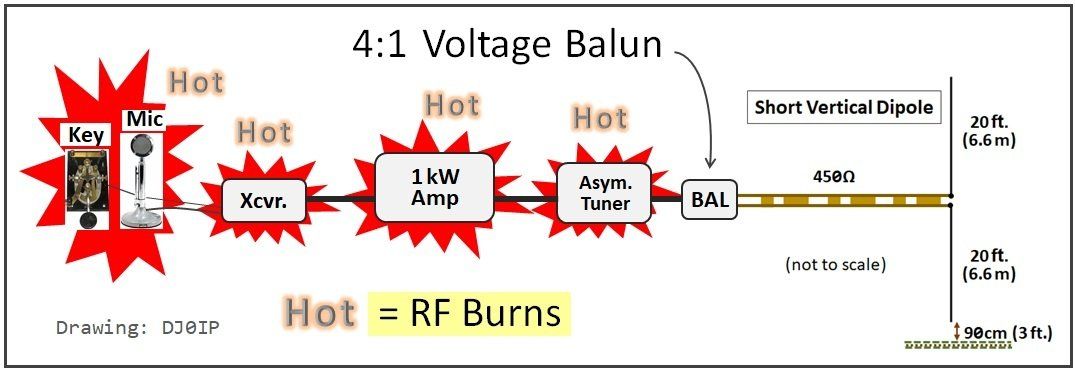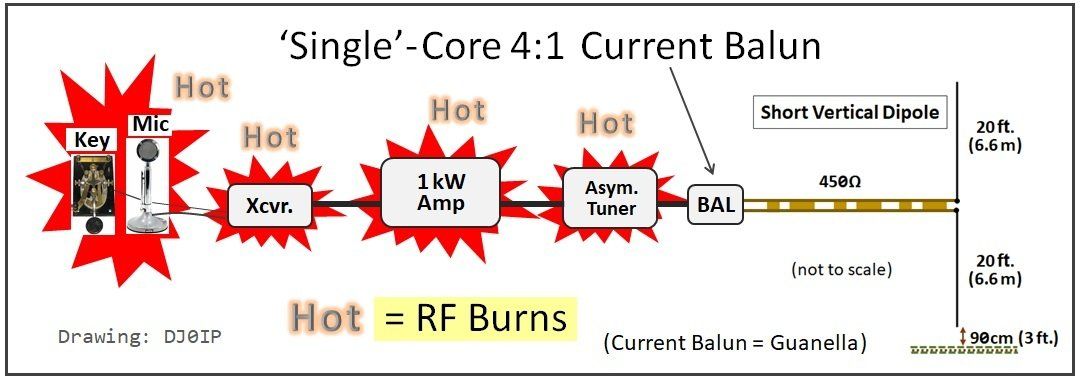WHERE SHOULD A TUNER BALUN BE PLACED?
This question has been disputed for a long time. Some claim it belongs on the antenna-side of the matchbox, others claim it belongs on the transmitter-side of the matchbox. Many "Experts" have offered their opinions, and I've read convincing technical arguments for both sides. Whom shall we believe?
ANSWER: NOBODY - Do your own due diligence!
I did mine. In my 45+ years experience using all sorts of openwire (balanced line) fed antennas in dozens of different locations, I have discovered a very simple, non-technical way to answer that question, using just one finger.
Note: if you only run QRP, or perhaps "barefoot" with just 100 Watts and your antenna is fairly well balanced, you might not notice much difference.
On the other hand, if you are feeding an antenna with openwire and know it is not well balanced, and you are running high power (i.e., 1 kW or more), it is very easy to see where to place your balun.
DANGER: when I tell you to touch the metal on one of the devices in your station while transmitting, you should do so 'quickly' (i.e., with a quick swipe) and with a dry finger!
The drawings below depict the various methods I have tried when matching many different antennas. The answer was easily found when using one of my favorite, the short vertical dipole, fed with openwire feedline.
The first drawing shows the solution I used for about 15 years. The ANNECKE "SYMMETRICAL KOPPLER" is a German antenna matchbox that is an improved version of the circuit used in the Johnson Viking Matchbox. See:

As an active contester, I ran two rigs simultaneously, both with 1 kW of power. I had two antennas, both fed with 450 Ohm feedline. One was horizontally polarized (80m dipole), the other (shown below) was vertically polarized. I needed two high-power symmetrical antenna matchboxes but only had one. The Annecke's were no longer available for sale. The Johnson Viking Kilowatt Matchbox has never been sold here in Germany, although a few units were left here by GI's returning to the states.
Several antenna matchbox manufacturers were advertising their asymmetrical (unbalanced) matchboxes as capable of matching balanced feedline - albeit, with the help of a built-in balun. At the time, nearly all of these baluns were 4:1 Ruthroff (voltage) baluns. I bought and tried several expensive matchboxes.
OUCH!
Although the vertical is fed with balanced line feedline, obviously this antenna system is not balanced, as the bottom half of the antenna is much closer to ground than the top half. Thus there was heavy Common Mode Current on the feedline,
which played havoc in the shack.

The Asymmetrical antenna matchbox shown here was not just one unit. I bought several different (expensive) antenna matchboxes, including a Palstar AT-4K and a TEN-TEC Model 238-A. I tried them with their internal 4:1 voltage (Ruthroff) baluns, as well as with an external 4:1 voltage balun.
No luck!
Researching the balun issue, I learned that a voltage balun was the wrong balun to use. A current balun was needed.
The RadioWorks in Virginia was advertising a high-power "Remote-Balun" - a 4:1 Current balun.
- I bought one and used it as pictured below.
- The results are also pictured below.
- Although rated for 1.5 kW, I promptly burned it up running 750 Watts, the maximum legal power here in Germany.
- I bought a second one; burned it up. :-(
Fritzel, a German manufacturer was advertising a 1.5 kW 4:1 balun out of its AMA series.
- I bought one and used it as pictured below. Same results. It promptly burned up.
- I bought another Fritzel balun, rated 2.5 kW; same results, but at least it lasted a bit longer before burning up. :-(

To be fair to the RadioWorks, if you read the specs of the Remote Balun carefully, it does say its power rating is "1.5 kW (power must be derated under some conditions)". However, from the advertising, power derating was not apparent, nor was the amount of power derating specified, nor the conditions defined where derating was necessary.
Today I understand all of that, but that was 20+ years ago.
STATION DESCRIPTION:
THE TRANSCEIVERS: a pair of Ten-Tec OMNI 6+ transceivers, powered by a Ten-Tec Model 961 and Model 962 power supplies. The power supplies had automatic circuit breakers that would trip whenever excessive current was drawn by the transceiver. This occurs in the presence of high SWR, but also in the presence of a high level of Common Mode Current.
THE LINEAR AMPLIFIERS: an HF-1000 and HF-2000 from QRO Technologies.
GROUND: "This" was a problem. My shack was on the 3rd floor of the building. When new electrical wiring was installed in our 60 year old house, I had the electrician run a thick (10mm) ground wire to the shack, in addition to the other wiring. It was pointless to run a ground wire outside to a ground stake.
THE PROBLEMS I WAS EXPERIENCING:
- The circuit breakers in the power supplies were tripping intermittently and often. I could only avoid this by reducing output power significantly. This seemed to occur most often on 15m with the vertical dipole but sometimes with the 80m horizontal dipole. It also occurred often on 40m.
- The equipment in the shack (everything) was HOT! Touching it resulted in RF burns. How severe depended on the power level, frequency, and choice of antenna.
- I was burning up expensive, high-power baluns on a regular basis. :-(
In desperation, I cut two pieces of hookup wire one quarter wavelength long; one for 40m and one for 15m. I connected them to the chassis ground of the antenna matchbox and simply strung them along the floor of the shack. THIS HELPED, SOMEWHAT.
AGAIN, NONE OF THESE PROBLEMS OCCURRED WHEN USING EITHER
OF MY TWO ANTENNAS WITH THE BALANCED LINK-COUPLED MATCHBOX!
These problems only occurred when using the asymmetrical (unbalanced) matchbox & balun.
In a conversation with K4TAX, Bob recommended I try a 1:1 balun. I was open for trying anything, so I tried it. The quickest way was to wrap about 25 ft. of RG-213 onto a PVC pipe of 10cm (4in.) O.D.
To my surprise, ALL of the problems listed above seemed to have vanished.
Gone with the Wind!
The "wind" being the "marketing hype" propagated by the balun manufacturers!
The next step was to replace the Big Ugly Monster Balun with a 1:1 Guanella balun, wrapped onto a single FT-240-43 ferrite core.
The results are shown below:

I was happy as a kid in a candy shop (when momma wasn't looking).
I wrapped my first 1:1 Guanella with bifilar windings, using Teflon-insulated copper wire. Then I built another using Teflon-insulated coax (RG-142). I could match both antennas on all bands with either of these two baluns.
I had read elsewhere that the balun works better when placed on the 50 Ohm side (TX side) of the matchbox. The "theory" behind this argument sounded good, so I tried it, as shown below:

As it turned out, that was a lousy idea.
Sure, it cured the hot lips and burnt fingers problem . . .
unless I happened to touch the matchbox cabinet when tuning.
IT GETS EVEN WORSE!
If you happen to ground all devices to a common ground bus, as we see universally recommended, you effectively give Common Mode Current an alternate path along the ground bus, around the balun.
Thus, the balun is rendered useless!

I did everything 'by the book' and it still burns! (Duh)
SUMMARY AND CONCLUSION
Like with most other topics in amateur radio,
there is theory, half-truths, rumors, myths
and finally there is practical reality.
In the case of matching a balanced-line fed antenna system, here is what I have learned through experience; not just a one-time-only test but years of trying all sorts of things:
- A Link-Coupled antenna matchbox such as the Annecke symmetrical "Koppler" has always worked great for me with any antenna and any power level.
- At QRP power levels, a 4:1 Ruthroff (voltage) balun used with a 100 Watt asymmetrical matchbox, such as the MFJ-901 has worked just fine, unless the antenna had low impedance to start with.
- When running 100 Watts of power, the balun in the MFJ-901 burned up, so I used an external 4:1 voltage balun with it. Depending on the antenna type and QTH, I would sometimes get moderate RF burns to my fingers.
- REAL TROUBLE begins when running high power (i.e., 500 Watts output, or more). When using an asymmetrical matchbox with a balun:
- Whether the balun is any good or not can be determined with one finger; simply touch the enclosure of the matchbox. DANGER: TOUCH IT QUICKLY!
- Voltage baluns do not work.
- Dual-Core 4:1 current baluns work if the antenna has moderate to high impedance on all bands
to be used - provided the antenna system is fairly well balanced
- Single-Core 4:1 current baluns do not work. They provide no Common Mode Impedance.
- It is imperative to use a 1:1 current balun, not a 4:1 balun whenever the antenna has low impedance or is not well balanced
- The balun must be on the output (antenna) side of the antenna matchbox.
- It is a good idea to use an additional Maxwell (W2DU, a.k.a. "line isolator") balun/choke on the input (transmitter) side of the matchbox. This is in addition to the Guanella balun on the output side of the matchbox.
- RF BURNS HURT !
FINAL COMMENTS
The information above shows practical examples of using various matchbox and balun technologies together with antenna systems fed with balanced line (openwire) feedline. However, it does not tell us anything about the efficiency (i.e., using a symmetrical matchbox compared to using an asymmetrical matchbox together with a balun.
Fundamentally, we are interested in 3 things:
- The amount of RF current transferred to the feedline.
- The balance of RF current transferred to the two lines of the feedline.
- The rejection of Common Mode Current on the feedline.
In his test of antenna matchboxes with different types of balanced-line fed antennas, Peter - KD7MW tested these three thing. His real-life test includes over 350 measurements, plus comments from Peter and me.
Peter's test begins here: KD7MW Antenna Matchbox Test
